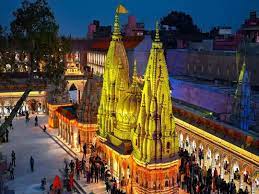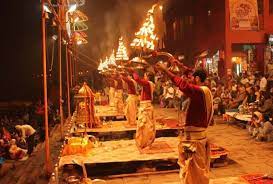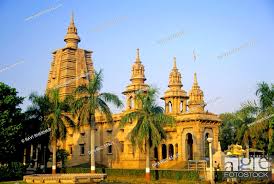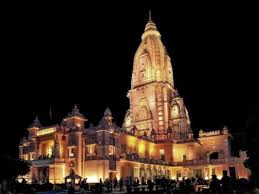Varanasi also Banaras or Benares and Kashi is a city on the Ganges river in northern India that has a central place in the traditions of pilgrimage, death, and mourning in the Hindu world. The city has a syncretic tradition of Muslim artisanship that underpins its religious tourism. Located in the middle-Ganges valley in the southeastern part of the state of Uttar Pradesh, Varanasi lies on the left bank of the river. It is 692 kilometres (430 mi) to the southeast of India's capital New Delhi and 320 kilometres (200 mi) to the east of the state capital, Lucknow. It lies 121 kilometres (75 mi) downstream of Allahabad (officially Prayagraj), where the confluence with the Yamuna river is another major Hindu pilgrimage site.
Varanasi is one of the world's oldest continually inhabited cities.[19] Kashi, its ancient name, was associated with a kingdom of the same name of 2,500 years ago. The Lion capital of Ashoka at nearby Sarnath has been interpreted to be a commemoration of the Buddha's first sermon there in the fifth century BCE. In the 8th century, Adi Shankara established the worship of Shiva as an official sect of Varanasi. Since ancient times, the city has been an important centre of Hindu devotion, pilgrimage, mysticism and poetry contributing to its cultural importance. Tulsidas wrote his Awadhi language epic, the Ramcharitmanas, a Bhakti movement reworking of the Sanskrit Ramayana, in Varanasi. Several other major figures of the Bhakti movement were born in Varanasi, including Kabir and Ravidas. In the 16th century, Rajput nobles in the service of the courts and armies of the Mughal emperor Akbar, sponsored the building or further enhancement of the major Shiva temple in the city; they also built other temples, all displaying an empire-wide architectural style. Under the Treaty of Faizabad, the East India Company acquired Benares in 1775, the city later successively becoming a part of the Benares Division in the Ceded and Conquered Provinces, the North-Western Provinces, and the United Provinces, and after India's independence of Uttar Pradesh.
Best Season to Visit
Winter season starts from November and lasts till March. The city becomes very cool during this period and the temperature even comes down to five degrees Celsius. Cold wind coming from the Himalayan region makes the environment even colder. This is definitely the best time to visit Varanasi.
Kashi Vishwanath Temple

The Kashi Vishwanath Temple is a famous Hindu temple dedicated to Lord Shiva. It is located in Vishwanath Gali of Varanasi, Uttar Pradesh in India. The temple stands on the western bank of the holy river Ganga, and is one of the twelve Jyotirlingas, the holiest of Shiva temples. The main deity is known by the names Shri Vishwanath and Vishweshwara (IAST: Vishveshvara or Vishveshvur) literally meaning Lord of the Universe. Varanasi was called Kashi ("shining") in ancient times, and hence the temple is popularly called Kashi Vishwanath Temple.
The temple is considered a central part of worship in the Shaiva culture by Hindu scriptures. It had been demolished several times by the Muslim rulers, most recently by Aurangzeb who constructed the Gyanvapi Mosque on its site.[1] The current structure was built on an adjacent site by the Maratha ruler, Ahilyabai Holkar of Indore in the year 1780.[2]
Since 1983, the temple has been managed by the government of Uttar Pradesh.
Dashashwamedh Ghat, Ganga Aarti

Dashashwamedh Ghat is a main ghat in Varanasi on the Ganga River in Uttar Pradesh. It is located close to Vishwanath Temple. Two Hindu legends are associated with it: according to one, Brahma created it to welcome Shiva, and in another, Brahma sacrificed ten horses during Dasa-Ashwamedha yajna performed here.
The present ghat was built by Peshwa Balaji Baji Rao in the year 1748. A few decades later, Ahilyabahi Holkar, the Queen of Indore, rebuilt the ghat in the year 1774.Close to the ghat, overlooking the Ganga lies the Jantar Mantar, an observatory built by Maharaja Jai Singh of Jaipur in the year 1737.
Ganga Aarti
Idol of "Ganga Maata" (Goddess Ganges) at Dashashwamedh Ghat.
Ganga Aarti (ritual of offering prayer to the Ganges river) is held daily at dusk. Several priests perform this ritual by carrying deepam and moving it up and down in a rhythmic tune of bhajans.[2] Special aartis are held on Tuesdays and on religious festivals.
The Ganga Aarti starts soon after sunset and lasts for about 45 minutes. In summer the Aarti begins at about 7pm due to late sunsets and in winter it starts at around 6pm. Hundreds of people gather at the ghat every evening to watch the event.
Sarnath

Sarnath , also referred to as Sarangnath, Isipatana, Rishipattana, Migadaya, or Mrigadava) is a place located 10 kilometres (6.2 miles) northeast of Varanasi, near the confluence of the Ganges and the Varuna rivers in Uttar Pradesh, India.
Sarnath is where, circa 528 BCE, at 35 years of age, Gautama Buddha taught his first sermon after attaining enlightenment at Bodh Gaya. It is also where the Buddhist sangha first came into existence as a result of the enlightenment of his first five disciples (Kaundinya, Assaji, Bhaddiya, Vappa and Mahanama). According to the Mahaparinibbana Sutta (Sutta 16 of the Digha Nikaya), the Buddha mentioned Sarnath as one of the four places of pilgrimage his devout followers should visit and look upon with feelings of reverence. The other three sites are Lumbini (the birthplace of the Buddha), Bodh Gaya (where the Buddha achieved enlightenment), and Kushinagar (where the Buddha attained parinirvana).
Banaras Hindu University

Banaras Hindu University (BHU) ( is a collegiate, central, and research university located in Varanasi, Uttar Pradesh, India, and founded in 1916. The university incorporated the Central Hindu College, founded by Indian Home Rule-leaguer and Theosophist, Annie Besant in 1898. After Besant and her associates were marginalized, the university was established by Madan Mohan Malaviya with the financial support of the maharaja of Dharbhanga Rameshwar Singh, the maharaja of Benares Prabhu Narayan Singh, and the lawyer Sunder Lal. With over 30,000 students, and 18,000 residing on campus, BHU is the largest residential university in Asia.The university is one of the eight public institutions declared as an Institute of Eminence by the Government of India.
BHU has often been referred by different names throughout the history and present. Some of the English names include Banaras University, Benares Hindu University, and Hindu University.
Boat Ride

Sunrise Boat Trip Highlights:
Witness rituals performed by Hindus on the ghats during sunrise and sunset evening (Hindu puja ceremony) Experience the best views of the Varanasi Ghats from the water. Enjoy sights of the Varanasi temples and buildings as the sun risesand at nightlight view of ghats. A great choice for small groups and families.